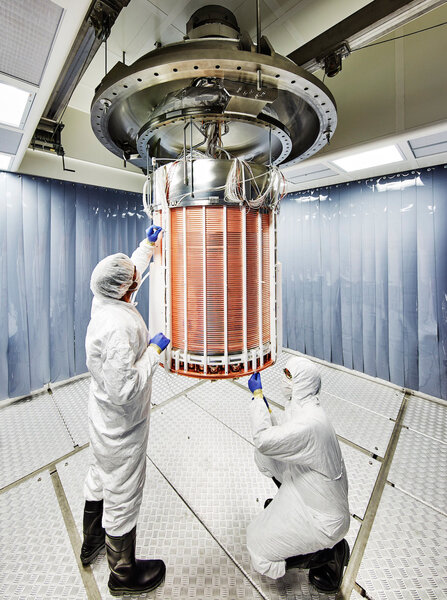Create a free profile to get unlimited access to exclusive videos, sweepstakes, and more!
Scientists witness the rarest event in the Universe yet seen

Over a kilometer below the surface of Italy, deep beneath the Gran Sasso mountain, lies a cylindrical tank. It’s roughly a meter high, a bit less than that wide, and it’s filled with an extraordinary substance: three and a half tons of ultra-pure xenon, kept liquid at a temperature of almost a hundred degrees Celsius below zero.
The tank is part of an experiment called XENON1T, and scientist built it in the hopes of detecting an incredibly rare event: an interaction of a dark matter particle with a xenon nucleus, predicted to occur if dark matter is a very specific kind of particle itself. Should they see such an event, it will nail down what dark matter is, and change the course of astronomy.
Unfortunately, they haven’t seen that yet. But instead, what they have seen is something far, far more rare: the decay of xenon-124 into tellurium-124. The conditions need to be so perfect for this to happen inside the nucleus of a xenon-124 atom that the half-life* for this event is staggeringly rare: It’s 1.8 x 1022 years.
Or, if you prefer, 18 sextillion years. Written out, that’s 18,000,000,000,000,000,000,000 years.
That’s a long time. How long? It’s comfortably over a trillion times the present age of the Universe.
So, yeah, that’s pretty rare. In fact, it’s the rarest event ever recorded. Ever.
Xenon is an element, like carbon or oxygen. It consists of a nucleus made up of 54 positively charged protons, and a whole bunch of neutral neutrons. Around the nucleus is a cloud of negatively charged electrons, one for every proton.
The number of protons is what defines an element. Hydrogen has one proton, helium two, and so on up the periodic table. Xenon has 54. The number of neutrons in the nucleus can be different from atom to atom, though. Atoms like these are called isotopes; the majority of xenon atoms have 75, 77, or 78 neutrons in them. But a small fraction of xenon atoms, about 0.1% (one out of a thousand), has only 70 neutrons. 54 + 70 = 124, so we call this isotope xenon-124.
Xenon-124 is extremely stable. If you have one of these atoms, it’ll pretty much just sit there for a long, long time. But not forever! In some atoms, there is an extremely rare event where an electron from the cloud around the nucleus suddenly finds itself inside the nucleus† where it can be absorbed by a proton. This process converts the pair into a neutron (and also winds up emitting a neutrino, another kind of subatomic particle).
This electron capture happens very rarely. But xenon-124 pushes this limit even harder: It can, very rarely, have two of these events happen at the same time. This is called double electron capture, and when it happens two protons each absorb an electron, change into a neutron, and emit a neutrino each. So this event is ridiculously rare; you’re taking a really uncommon event and making it happen twice at the same time.
It does happen, though. And when it does, the xenon-124 changes because two of its protons are now neutrons. It’s no longer xenon, but an atom with 52 protons: tellurium. And this brand-new tellurium atom has a problem: Two of its lowest energy electrons are gone now, too. This is like kicking out the bottom floor of a building; the higher-energy electrons crash down to the lower energy levels, and when they do that they emit very specific colors of light (in fact a similar process makes nebulae, gas clouds in space, glow, as well as neon or even xenon signs).
Xenon glows blue when excited by an electric field. These glass tubes, shaped in xenon’s element symbol, are filled with xenon gas. This doesn’t have anything to do with the article, really, but I thought it was fun and clever. Credit: Pslawinski / wikipedia
It was the emission of this extremely narrow slice of colored light that scientists saw in their tank of xenon! Although the double electron capture is extremely rare, they have 3.5 tons of xenon in the tank, which is a lot of atoms (26,700 moles, or 1.6 x 1028 atoms, so yeah, a lot). When you have that many atoms, even super rare events will happen.
… not that they’re easy to detect. A lot of other events can give off light that interferes with detecting the flashes of light from the xenon decaying into tellurium. But that’s why the tank is 1.5 kilometers underground; the sheer amount of rock above them protects the tank from quite a bit of quantum noise. It’s also surrounded by a tank of water, which absorbs subatomic particles coming in from the rock, too. This all shields the xenon pretty effectively, so when the decay occurs, scientists can detect it.
Over the course of a year (from 2017 - 2018) they detected something like 126 of these flashes (due to the methods they use to detect them, there’s some uncertainty in that, so it’s really 126 ± 29). Knowing how much xenon they have, the length of time they looked, and the number of flashes, they could calculate the half-life of xenon-124: 1.8 x 1022 years.
Two scientists examine the partially assembled XENON1T tank before installation deep underground in Italy. Credit: Roberto Corrieri and Patrick De Perio / Laboratori Nazionali del Gran Sasso
It turns out this same process happens in isotopes of krypton and barium, and while these also have soul-crushingly long half-lives, they’re somewhat less than xenon-124’s. That makes the events detected in the XENON1t experiment the rarest ones ever seen.
Think of it this way: If they have 3.5 tons of xenon in the tank, and 0.1% of those atoms are xenon-124, that means they have 3,500 grams of that isotope in the tank. It’ll stay that way for a while, but if they wait long enough — 18 sextillion years — they’ll only have 1,750 grams of xenon-124 left. The other half will have decayed into tellurium.
That’s so cool! But it’s important, too: It’s been hard to pin this number down (you need extremely sensitive detectors in a highly shielded environment), and it’s important to nuclear physics to nail down other properties of the element. Also, there’s an ongoing debate about the nature of neutrinos — the technical details are, um, complicated — but if one side is right then the standard model of subatomic particles is right, but if the other side is right than the standard model is wrong. It’ll be a while before someone can settle this debate, but getting the half-life of xenon-124 (which emits neutrinos) is a step closer to figuring that out.
And, hey, I get it: This may seem weird and esoteric, but this is how the Universe works. Some processes are obvious and spectacular, like exploding stars or slipping on a banana peel (that’s physics, folks), but others are subtle, and rare. But they are no less impactful; a whisper in your ear can be just as provocative as an orchestra blasting out the finale to a symphony. Both have their impact.
At the moment, the XENON1T experiment has been temporarily suspended for an upgrade; when the equipment is finished, the XENONnT experiment will have three times the amount of xenon in it, allowing scientists to study this phenomenon even more.
And this isn’t even getting into the main purpose of the experiment, which is to detect dark matter … but that will have to wait for another day to explain. In the meantime, if you want to learn more about that, this guy can tell you about it:
*A half-life is a convenient way to measure how long it takes something to change from one substance into another. For example, uranium-238 atoms decay into thorium with a half-life of 4.47 billion years. So, if you start off with a kilo of uranium-238, in 4.47 billion years you’ll have half a kilo each of uranium and thorium. You can’t know when any individual atom will decay, but when you have a lot the statistics become pretty solid.
† It does this through a process called quantum tunneling, which is exceptionally weird — as is all of quantum mechanics, really — but it’s a well-understood process responsible for a lot of effects we rely on, like nuclear fission, nuclear fusion (which powers the Sun), and even the semi-conductors in electronics.



























